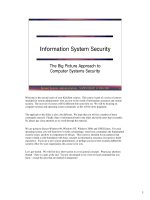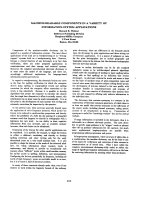Information system ralph syllabus
Bạn đang xem bản rút gọn của tài liệu. Xem và tải ngay bản đầy đủ của tài liệu tại đây (142.37 KB, 9 trang )
Jordan University of Science & Technology
Faculty of Computer & Information Technology
Department of Computer Information Systems
Year:
2010/2011
Semester:
Second( Semester)
Course Information
Course Title
Information Systems
Course Number
Prerequisites
Course Website
CIS 230
CIS 200
/>
Instructor
Dr. Ismail Hmeidi
Office Location
Ph 4 Level 0
Office Phone
7201000
Office Hours
Ext. 23400
10 -11 TU, TH & by appointment
Teaching Assistant
Text Book
Title
Information Systems Essentials
Author(s)
Ralph M. Stair , George W. Reynolds
Publisher
McGraw Hill
Year
2010
Edition
Book Website
References
Fifth Edition
/>
Information Systems , the foundation of E-Business ,Steven Alter ,3 rd
Edition
Information Systems ,Success in the 21st Century , Uma G. Gupta
Assessment Policy
Assessment Type
Expected Due Date
Weight
First Exam
TBA
20%
Second Exam
TBA
20%
Final Exam
TBA
40%
Quizzes
TBA
TBA
15%
Case Study
Total
5%
100%
Catalog Description
This course is to present a core of Information Systems principles
with which every Is student should be familiar, such as: An
introduction to information Systems in organizations. Hardware and
Software: systems and application software. Database systems
and business intelligence. Telecommunication, the internet,
intranets, and extranets .Electronic and mobile commerce and
expert systems, and information and decision support systems.
Course Objectives
Weights
1. Presents basic concepts necessary to understand systems (10%)
and business information systems.
( 10%)
2. The use of information systems to add value to the
organization is strongly influenced by organizational
(10%)
structure, culture, and change
3. Hardware component of computer-based information
(10%)
system.
(10%)
4. Software functions
5. organizing data and information, describes basic concepts (10%)
that are essential to understanding the key functions in,
and impacts of, data storage and database management
systems
(10%)
6. Telecommunications and Networks, describes basic (10%)
concepts and components of networks used for data
communications.
(10%)
7. The Internet, Intranets, and Extranets, covers the Internet (10%)
and its use and effects.
8. Introduce the students to E-commerce.
9. Identify the basic activities and business objectives
common to all transaction processing systems.
10.Discusses information systems used for decision-making
and problem solving in business, including management
information systems and decision support systems
Learning Outcomes:
Upon successful completion of this course, students
should
Related
Objective
The expected achieved outcome
Reference
1
Distinguish data from information and describe the Chapter 1
characteristics used to evaluate the value of data.
Identify the basic types of business information systems
and discuss who uses them, how they are used, and what
kinds of benefits they deliver.
Identify the major steps of the systems development
process and state the goal of each.
Identify the value-added processes in the supply chain
and describe the role of information systems within them
Identify some of the strategies employed to lower costs or
improve service.
Define the term competitive advantage and discuss how
organizations are using information systems to gain such
an advantage.
Define the types of roles, functions, and careers available
in information systems
3
Identify and discuss the role of the essential Chapter 2
hardware components of a computer system
Identify the characteristics of and discuss the
usage of various classes of single-user and multiuser
computer systems
Identify and briefly describe the functions of the
two basic kinds of software
Outline the role of the operating system and
identify the features of several popular operating
systems
Discuss how application software can support
personal, workgroup, and enterprise business
objectives
Identify three basic approaches to developing
application software and discuss the pros and cons of
each
Outline the overall evolution and importance of
programming languages and clearly differentiate
among the generations of programming languages
Identify several key software issues and trends
that have an impact on organizations and individuals
5
6
7
Define general data management concepts and Chapter 3
terms, highlighting the advantages of the database
approach to data management
Describe the relational database model and
outline its basic features
Identify the common functions performed by all
database management systems, and identify popular
database management systems
Identify and briefly discuss current database
applications
Identify
and
describe
the
fundamental Chapter 4
components of a telecommunications system including
media and hardware devices
Identify several network types and describe the
uses and limitations of each
Name three basic processing alternatives for
organizations that require two or more computer
systems and discuss their fundamental features
Briefly describe how the Internet works, including
alternatives for connecting to it and the role of Internet
service providers
Describe how the World Wide Web works and the
use of Web browsers, search engines, and other Web
tools
Identify and briefly describe several applications
associated with the Internet and the Web
Outline a process and identify tools used to
create Web content
Define the terms intranet and extranet and
discuss how organizations are using them
Identify several issues associated with the use of
networks
Describe the current status of various forms of ecommerce, including B2B, B2C, C2C, and m-commerce
Identify several e-commerce and m-commerce
applications
Identify several advantages associated with the use of ecommerce and m-commerce
Chapter 5
Identify the key components of technology infrastructure
that must be in place for e-commerce and m-commerce to
work
Discuss the key features of the electronic payment
systems needed to support e-commerce and m-commerce.
Identify the basic activities and business objectives
common to all transaction processing systems
Identify key control and management issues associated
with transaction processing systems
Discuss the advantages and disadvantages associated
with the implementation of an enterprise resource
planning system
Identify the challenges multinational corporations must
face in planning, building, and operating their TPSs
Define the stages of decision making.
9 + 10
Discuss the importance of implementation and monitoring
in problem solving.
Explain the uses of MIS and describe their inputs and
outputs.
Discuss information systems in the functional areas of
business organizations.
List and discuss important characteristics of DSSs that
give them the potential to be effective management
support tools.
Identify and describe the basic components of a DSS.
State the goals of a GSS and identify the characteristics
that distinguish it from a DSS.
Identify the fundamental uses of an ESS and list the
characteristics of such a system.
Discuss the differences among data, information, and
knowledge.
6
Describe the role of the chief knowledge officer (CKO)
List some of the tools and techniques used in knowledge
management
Define the term artificial intelligence and state the
objective of developing artificial intelligence systems.
List the characteristics of intelligent behavior and
compare the performance of natural and artificial
intelligence systems for each of these characteristics.
Identify the major components of the artificial intelligence
field and provide one example of each type of system.
List the characteristics and basic components of expert
systems.
Identify at least three factors to consider in evaluating the
development of an expert system.
Outline and briefly explain the steps for developing an
expert system.
Identify the benefits associated with the use of expert
systems.
Define the term virtual reality and provide three examples
of virtual reality applications.
Discuss examples of specialized systems for
organizational and individual use.
Teaching & Learning Methods
Class lectures, lecture notes, and case study are designed to achieve the course objectives.
You should read the assigned chapters before class, complete assignments on time, participate
in class and do whatever it takes for you to grasp this material. Ask questions. Ask lots of
questions.
You are responsible for all material covered in the class.
Please communicate any concerns or issues as soon as practical either in class, by phone or
by Email.
The web page is a primary communication vehicle. Lecture notes will be available before each
class. It will contain homework assignments, study guides, and important instructions.
Course Content
Week
Topics
Chapter in Text
PART 1: Information Systems in Perspective
1-3
Course Introduction
An Introduction
Organizations
to
Information
Systems
in
1
PART 2: Technology
4-5
Hardware and Software
2
6-7
Database Systems and Business Intelligence
3
8-10
Telecommunications, The Internet, Intranets, and
Extranets
4
Part 3: Business Information Systerms
11-12
Electronic and Mobile Commerce and Enterprise
Systems
5
12-13
Information and Decision Support Systems
6
14-15
Knowledge
Management
Information Systems
and
Specialized
7
Part 4: Systems Development and Social Issues
16
Systems Development
8
Part 5: Information Systems in Business and
Society
17
The personal and Social Impact pf Computers
9
Additional Notes
Homework's
No Homework's
Exams
The format for the exams is generally Multiple-choice ( on
To make sure you pass the exams, you should do the b Quizzes.
Grades will not be given out via e-mail
Makeup Exams
line )
Makeup exam should not be given unless there is a valid excuse.
Arrangements to take an exam at a time different than the one scheduled
MUST be made prior to the scheduled exam time.
Drop Date
Cheating
Last day to drop the course is before the twelve (12th) week of the current
semester.
Cheating or copying from neighbor on exam, quiz, or homework is an
illegal and unethical activity.
Standard JUST policy will be applied.
All graded assignments must be your own work (your own words).
Some of the assignments (programming or homework) may be graded
orally.
Additional Notes (Continue)
Attendance
Excellent attendance is expected.
JUST policy requires the faculty member to assign ZERO grade (35) if a
student misses 10% of the classes that are not excused.
Sign-in sheets will be circulated.
If you miss class, it is your responsibility to find out about any
announcements or assignments you may have missed.
Workload
Average work-load student should expect to spend is 4 hours/week
Graded Exams
Instructor should return exam papers graded to students not after the
week after the exam date.( On line Exam)
Participation
Participation in, and contribution to class discussions will affect your final
grade positively. Raise your hand if you have any question.
Making any kind of disruption and (side talks) in the class will affect you
negatively.
Free Lab
No Lab
Case Study
A team of 2 students is expected to submit a case.
In Class presentation
Make backups of all of your work.
Finally
This includes any assignment and project materials you and your group
produce.
Copy files onto 2 or 3 floppy disks and photocopy diagrams and other
materials to share with your group









